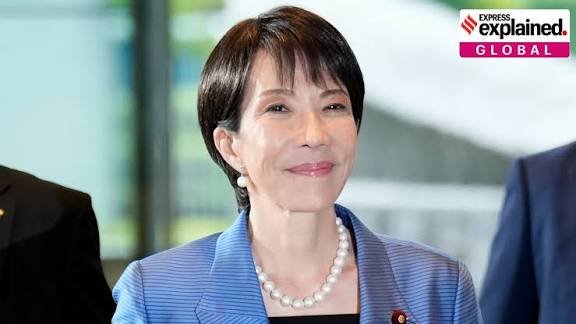Sanae takaichi immigration: policies,5 things,first female prime minister

Takachi’s cabinet signaled changes in Japan’s immigration, defense policy. The government is keeping an eye on foreigners who do not follow the rules. Today we will discuss about Sanae takaichi immigration: policies,5 things,first female prime minister
Sanae takaichi immigration: policies,5 things,first female prime minister
In a historic moment for Japan, Sanae Takaichi became the first woman to serve as Prime Minister, marking a breakthrough in the nation’s political landscape. Her rise represents not only a milestone for gender equality in Japanese politics but also signals a new direction for several key policies — particularly immigration.
This article explores her background, her stance on immigration, and the five defining aspects of her approach. It also examines what her leadership could mean for Japan’s future, as the country grapples with demographic challenges, economic security, and social cohesion.
Who Is Sanae Takaichi?

Born in 1961 in Nara Prefecture, Sanae Takaichi is known for her strong work ethic, conservative values, and close political ties to the late Prime Minister Shinzo Abe. After graduating from Kobe University, she entered politics in 1993 and joined the Liberal Democratic Party (LDP) three years later.
Over her long career, Takaichi has held multiple ministerial posts, including Minister for Internal Affairs and Communications and Minister of State for Economic Security. She became the LDP’s policy research chairperson before rising to the party’s leadership in 2025 — and eventually, the premiership.
Takaichi is often described as a staunch conservative nationalist and a political protégé of Abe. Her admiration for Margaret Thatcher is well known, and her leadership style reflects discipline, patriotism, and economic pragmatism.
Her appointment as Japan’s first female Prime Minister is a watershed moment — but her policies, particularly her stance on immigration, reveal a pragmatic yet cautious approach to social and demographic reform.
Takaichi’s Immigration Policy: Balancing Order, Security, and Coexistence
Immigration reform is a cornerstone of Takaichi’s agenda. While she recognises Japan’s need for foreign workers amid an ageing population, she insists that immigration must occur under strictly controlled, lawful, and culturally compatible conditions.
Her policy framework focuses on three guiding principles:
-
National stability and social order
-
Harmonious coexistence between Japanese citizens and foreign residents
-
Selective openness to skilled and compliant foreign workers
Takaichi has stated repeatedly that tightening immigration rules is not an act of exclusion, but rather a way to maintain societal harmony. Her approach combines integration support for foreigners who live by Japan’s laws with strict enforcement against violations.
To manage this balance, her administration has even created a new ministerial position — “Minister in charge of a society of well-ordered and harmonious coexistence with foreign nationals.” This signals her intent to institutionalize Japan’s immigration strategy as part of national governance.
Five Key Things to Know About Takaichi’s Immigration Policy
1. Stricter Entry and Residency Controls
A defining feature of Takaichi’s approach is tougher entry and residency regulation. She emphasizes that immigration should be based on adherence to Japanese law and respect for local culture.
Her policy direction calls for:
-
Enhanced border control and visa screening
-
Rigorous monitoring of overstayers and illegal residents
-
Enforcement of residency compliance through coordinated administrative systems
Takaichi insists that immigrants must “strictly obey our laws,” underscoring her belief that integration begins with legal and cultural respect. This is likely to result in more stringent eligibility criteria for visas and permanent residency.
2. Focus on “Orderly Coexistence,” Not Open Borders
Unlike Western liberal immigration models, Takaichi’s philosophy is centered on “orderly coexistence” rather than mass immigration. She envisions Japan as a society where foreigners are welcomed selectively — but must integrate seamlessly and respect social norms.
Her statements consistently stress that Japan should avoid uncontrolled influxes that could destabilize communities. Instead, she advocates for structured acceptance based on mutual respect and order.
This approach appeals to conservative voters who value stability, while still recognizing Japan’s demographic needs. It reflects an attempt to strike a middle ground between isolationism and full liberalization.
3. Integration Support Coupled with Enforcement
Takaichi’s administration aims to strengthen both support systems for foreign residents and enforcement mechanisms for rule compliance.
Her plan involves:
-
Expanding language education and cultural orientation programs
-
Establishing local administrative support centers for foreign workers and families
-
Introducing clear guidelines for social behavior and legal obligations
-
Coordinating national and local efforts under a new Office for Harmonious Coexistence
This dual-track model — support plus enforcement — seeks to improve integration outcomes while minimizing tensions between foreign residents and local communities. It’s a pragmatic approach designed to ensure that foreigners can succeed in Japan without disrupting social harmony.
4. Linking Immigration to National Security and Economic Policy
Takaichi’s experience as Minister of Economic Security influences how she connects immigration with national defense, economic stability, and social resilience.
Under her framework, immigration is not just a social issue but a strategic component of Japan’s long-term survival. She views migration policy as part of Japan’s national security system, designed to:
-
Protect industries from over-dependence on foreign labor
-
Secure skilled talent in strategic sectors
-
Prevent potential security risks linked to unregulated migration
-
Maintain cultural and ideological coherence amid globalization
This mindset aligns with her conservative nationalism. Immigration policy, in her view, must support Japan’s economic self-reliance, not weaken it.
5. Addressing Demographic Challenges Without Sacrificing Social Order
Japan faces severe demographic issues — a rapidly ageing population, low birth rate, and shrinking workforce. Most economists agree that foreign labor will be essential for sustaining productivity.
Takaichi acknowledges this, but she remains wary of large-scale immigration. Instead, she promotes a selective approach:
-
Encouraging high-skill migration in science, technology, and healthcare
-
Enhancing temporary worker programs under strict oversight
-
Promoting automation and AI to offset labor shortages
-
Maintaining cultural and linguistic cohesion as a national priority
Her administration must navigate the delicate balance between demographic necessity and social conservatism — ensuring that Japan remains both competitive and cohesive.
Why Her Immigration Policy Matters
Takaichi’s immigration strategy will shape Japan’s future in several crucial ways:
-
Demographic Sustainability – With one of the world’s oldest populations, Japan must attract talent and labor to sustain its economy.
-
Economic Competitiveness – Industries from construction to caregiving depend on foreign workers. Clearer immigration systems could stabilize these sectors.
-
Social Cohesion – Managing integration effectively is vital to prevent tensions in increasingly diverse communities.
-
Global Diplomacy – Immigration policy affects Japan’s relationships with partner nations that supply foreign workers, particularly in Southeast Asia.
-
Cultural Identity – Japan’s immigration debate is also about preserving its distinct identity while adapting to a changing world.
Takaichi’s approach — conservative but structured — aims to protect all five dimensions simultaneously.
Criticisms and Challenges
Despite her strategic vision, Takaichi’s immigration stance faces notable criticism and practical obstacles.
1. Perception of Restrictiveness
Some critics argue her policies could discourage foreign talent from coming to Japan by making immigration appear bureaucratic and unwelcoming.
2. Integration Risks
Strict enforcement without sufficient community support might alienate foreign residents, leading to social isolation or discrimination.
3. Workforce Shortages
Japan’s urgent need for labor in sectors like healthcare, manufacturing, and agriculture may conflict with restrictive immigration rules.
4. Political Resistance
Implementing major reforms requires parliamentary consensus. Her coalition, while historic, may face resistance from factions favoring more liberal policies.
5. Symbolism vs. Substance
Though she broke a gender barrier, critics say her cabinet composition — with few women — shows limited progress toward real diversity. Her immigration policies, too, may be seen as more symbolic than transformative.
Key Indicators to Watch During Her Tenure
Observers can gauge the direction of Takaichi’s immigration reforms through several indicators:
-
Visa Regulation Changes – Adjustments to categories for skilled, technical, and long-term visas will reveal whether policy is tightening or modernizing.
-
Institutional Reforms – The success of the new Minister for Harmonious Coexistence will indicate how serious the administration is about integrated immigration management.
-
Integration Metrics – Language acquisition, community participation, and public sentiment among foreign residents will show how well policies are working.
-
Economic Outcomes – Labor-market data will reveal whether the policies address Japan’s workforce shortages or worsen them.
-
International Cooperation – Trade and labor agreements with Southeast Asian countries will signal whether Japan is deepening or limiting its reliance on foreign labor.
Implications for Foreign Residents and Future Migrants
Under Takaichi’s leadership, life for foreigners in Japan may evolve in several key ways:
-
Stricter Compliance Requirements – Residency and work-visa enforcement will likely intensify.
-
More Structured Integration Programs – Expanded language and administrative services could improve daily life for compliant residents.
-
Selective Access for Skilled Workers – High-skill migrants may find clearer pathways, but low-skill workers could face tougher barriers.
-
Stable but Controlled Environment – Japan will remain safe and predictable for foreign residents, though not necessarily more open.
-
Opportunities in Specific Sectors – Sectors facing acute labor shortages — healthcare, IT, caregiving, and construction — may still welcome foreign professionals.
In essence, Japan under Takaichi will likely be a country open to qualified, law-abiding, and integrated foreigners, rather than a broad immigration destination.
The Broader Context: Gender, Leadership, and Legacy
Takaichi’s appointment as the first female Prime Minister has immense symbolic value. However, her political philosophy emphasizes competence and continuity over revolution and reform.
Her rise shows that women can achieve the highest office in Japan, even within a traditionally conservative framework. Yet, her policies — immigration included — reflect the pragmatism of a traditionalist, not the radicalism of a reformist.
She aims to reshape Japan not by dismantling its systems, but by re-enforcing discipline, structure, and order within them. Immigration, therefore, becomes both a practical necessity and a test of Japan’s capacity to adapt without losing identity.
Conclusion
Sanae Takaichi’s tenure marks a new chapter in Japan’s political and social evolution. As the first female Prime Minister, she carries the weight of history — but also the burden of expectation.
Her immigration policy is likely to be structured, selective, and security-minded rather than open-door or liberal. She seeks to reconcile Japan’s need for foreign labor with its desire for cultural cohesion and social stability.
Under her leadership, Japan’s immigration system will evolve toward a model of “harmonious coexistence” — where foreigners can contribute to the economy while respecting Japanese customs and laws.
Whether this model succeeds will depend on how well her government balances compassion with control, inclusion with integrity, and progress with preservation.
In the years to come, Sanae Takaichi’s approach may redefine not only how Japan manages immigration, but also how it reconciles tradition and transformation in a changing world.
How useful was this post?
Click on a star to rate it!
Average rating 0 / 5. Vote count: 0
No votes so far! Be the first to rate this post.
About the Author
usa5911.com
Administrator
Hi, I’m Gurdeep Singh, a professional content writer from India with over 3 years of experience in the field. I specialize in covering U.S. politics, delivering timely and engaging content tailored specifically for an American audience. Along with my dedicated team, we track and report on all the latest political trends, news, and in-depth analysis shaping the United States today. Our goal is to provide clear, factual, and compelling content that keeps readers informed and engaged with the ever-changing political landscape.




